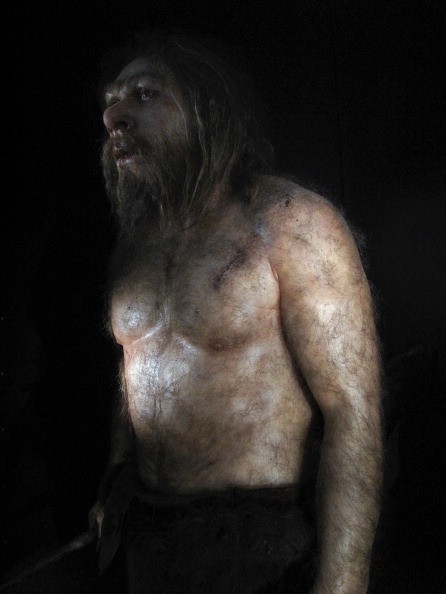Neanderthal Facts: 5 Things About Extinct Species That May Be Modern Man’s Ancestor
| KJ Belonio | | Jun 23, 2015 05:05 AM EDT |
(Photo : Getty Images/Cristina Arias ) In a recent study published in the journal Nature, an international team of researchers suggests that modern humans and Neanderthals interbred in Europe.
Neanderthal Facts - We often hear the term "Neanderthal" used by scriptwriters in our favorite movies or literary authors in our favorite books. But did you know its real meaning?
Neanderthal refers to the primitive humans who lived throughout Europe. Based on its definition on Urban Dictionary, the term "Neanderthal" was derived from the Neanderthal Valley in Germany, where the first fossils were found. In literature, "Neanderthal" is often used either as an adjective to describe men who have caveman behavior or as a noun referring to men who are stupid and rude or who has very old-fashioned ideas and who does not like change.
Like Us on Facebook
In a recent study published in the journal Nature, an international team of researchers suggests that modern humans and Neanderthals interbred in Europe. According to BBC News, the team comprehensively analyzed a 40,000-year-old DNA sample extracted and sequenced the genetic material from a jawbone found in 2002 inside the cave system of Pestera cu Oase in southwest Romania.
The new results revealed that the ancient man was found more closely related to Neanderthals (Homo neanderthalensis) than any other modern human (Homo sapiens) who has previously analyzed.
"It is such a lucky and unexpected thing to get DNA from a person who was so closely related to a Neanderthal," Germany's Max Planck Institute for Evolutionary Anthropology lead scientist Professor Svante Paabo said. "I could hardly believe it when we first saw the results."
Meanwhile, as Neanderthal is linked to being modern man's ancestor, here are 5 interesting facts that will give an insight about our closest extinct human relatives.
1. Neanderthals had been living in Europe for more than 200,000 years when the first early modern humans left Africa to colonize Europe and Asia. Daily Mirror has learned that humans and Neanderthals co-existed in Eurasia for 5,000 years before Neanderthals became extinct almost 40,000 years ago.
2. The reason for Neanderthal extinction is still unclear; however, experts believed that they may have been unable to compete with more sophisticated modern humans for essential resources such as food and shelter.
3. Neanderthals have a similar appearance to modern humans. However, they were shorter and stockier with angled cheekbones, prominent brow ridges, and wide noses. Live Science noted that their short, stocky stature was an evolutionary adaptation for cold weather, since it consolidated heat, whereas the wide nose helped humidify and warm cold air.
4. The American Museum of Natural History stated the other differences from humans are a flaring, funnel-shaped chest, a flaring pelvis, and robust fingers and toes. Their brains, on the other hand, grew at a similar rate to humans' and were about the same size or larger. Just about 1 percent of Neanderthals had red hair, light skin, and maybe even freckles.
5. The genes inherited from Neanderthals are linked to modern ailments, Mental Floss revealed. According to a January 2014 study from the Harvard Medical School, Crohn's disease, lupus, type 2 diabetes, as well as human's potential for becoming a smoker, can be traced back to genetic variants inherited from Neanderthals.
Tagsneanderthals, Modern Man, Ancestry, Lineage, Study, Science
©2015 Chinatopix All rights reserved. Do not reproduce without permission
EDITOR'S PICKS
-

Did the Trump administration just announce plans for a trade war with ‘hostile’ China and Russia?
-

US Senate passes Taiwan travel bill slammed by China
-

As Yan Sihong’s family grieves, here are other Chinese students who went missing abroad. Some have never been found
-

Beijing blasts Western critics who ‘smear China’ with the term sharp power
-

China Envoy Seeks to Defuse Tensions With U.S. as a Trade War Brews
-

Singapore's Deputy PM Provides Bitcoin Vote of Confidence Amid China's Blanket Bans
-

China warns investors over risks in overseas virtual currency trading
-

Chinese government most trustworthy: survey
-

Kashima Antlers On Course For Back-To-Back Titles
MOST POPULAR
LATEST NEWS
Zhou Yongkang: China's Former Security Chief Sentenced to Life in Prison

China's former Chief of the Ministry of Public Security, Zhou Yongkang, has been given a life sentence after he was found guilty of abusing his office, bribery and deliberately ... Full Article
TRENDING STORY

China Pork Prices Expected to Stabilize As The Supplies Recover

Elephone P9000 Smartphone is now on Sale on Amazon India

There's a Big Chance Cliffhangers Won't Still Be Resolved When Grey's Anatomy Season 13 Returns

Supreme Court Ruled on Samsung vs Apple Dispute for Patent Infringement

Microsoft Surface Pro 5 Rumors and Release Date: What is the Latest?










